Comparative characteristics of heating radiators made of different materials: how to choose durable ones?
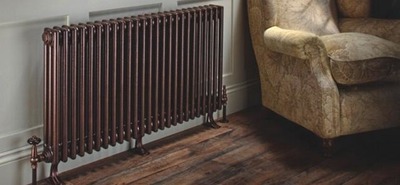
Heating radiator or battery - convective-radiation type room heating device, consisting of several sections (ribs), inside which there is a channel for conducting the coolant: water, special antifreeze or steam.
Dark colored batteries are more efficient for heating.
How radiators work
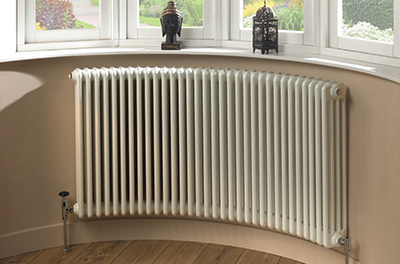
By passing the heated energy carrier through itself, the battery heats up itself and distributes heat in the room. The heat from the device goes in three ways:
- radiation — when heated to a certain temperature, the surface of the device begins to emit waves of a certain length, heating the room;
- convection — by heating the air, the battery starts the process of natural circulation of cold and hot gases;
- thermal conductivity — heating the radiator itself from the coolant and transferring this heat to the surrounding space.
Types of central heating batteries
According to the material from which they are made, batteries are divided into:
- cast iron;
- aluminum;
- steel;
- bimetallic.
Decorative cast iron
Traditional batteries, widespread everywhere. Used in production grey cast ironCast iron units are:
- single-channel;
- dual-channel;
- three-channel.
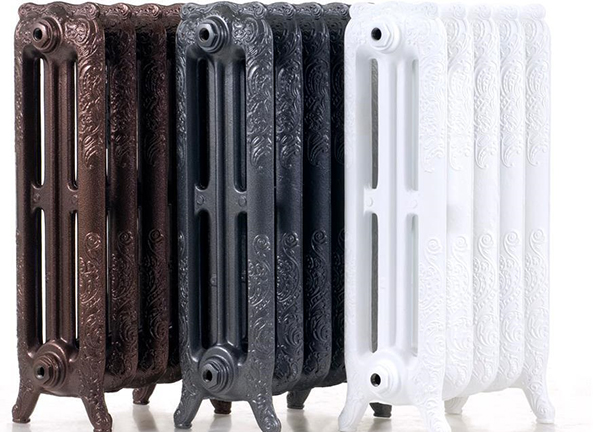
Photo 1. Three decorative cast iron radiators of different colors, they are durable and not subject to corrosion.
Modern models have changed for the better compared to Soviet models:
- design - presence of decorative patterns, different colours, smooth surface, legs - the device does not need to be mounted on the wall with brackets;
- dimensions — radiators can be installed under any window sills;
- improved heat dissipation;
- the ability to withstand high pressure.
Pros and cons
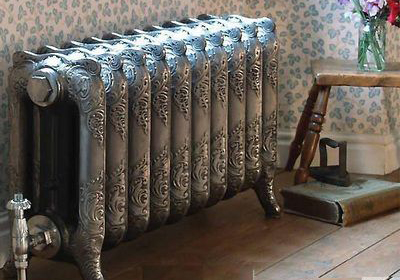
The advantages that determine their popularity are:
- durability;
- loyalty to the quality of the liquid;
- no complex maintenance;
- high heat capacity;
- wall thickness;
- corrosion resistance;
- uniformity of heating;
- resistance to mechanical impacts.
The disadvantages include:
- inconvenience of installation;
- instability to sudden pressure changes;
- difficulty washing;
- heaviness;
- impossibility of use in the automation system.
Important! The most popular are the CM models. They can withstand temperatures up to 150 °C, resistant to any energy sources.
The heat output of the radiator device is indicated in the technical data sheetBut in reality, the passport data always differs from the “behavior” of the battery in the house.
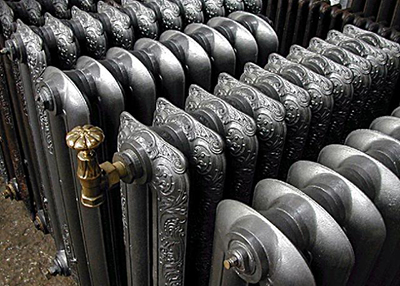
This is due to the fact that radiator tests are carried out in almost ideal conditions, which is not the case in an ordinary home.
Approximate power of one section of the radiator at h=500, temperature of the energy carrier in 70 °C and working pressure 6-9 atmospheres makes up 110 W. To understand the power of a battery, you need to multiply the number of ribs by this figure.
Subject to maintenance conditions, periodic cleaning and replacement of inter-section gaskets, the average service life of batteries is 50 years and longer.
How much do they cost?
The price range for cast iron radiators is quite wide: from inexpensive ones for 700 rubles to 11,500.
The cost is influenced by:
- number of ribs;
- design;
- manufacturer.
Reference! An additional factor will be the place of purchase: you can buy the device online cheaper, than a similar one in an offline store.
Inexpensive aluminum
It is a bit of a mistake to talk about these radiators as only aluminum ones - they are made of aluminum alloy with additives, which gives the parts strength. Batteries of this type are divided into two groups:
- Sectional – consist of separate sections, from which you can assemble a battery of the required length or add on if necessary. from six to sixteen atmospheres, have an expanded channel for free flow of coolant. They are manufactured by casting.
- Collector — fixed-size panels that are pressed together from individual parts. Cannot be upgraded during operation.
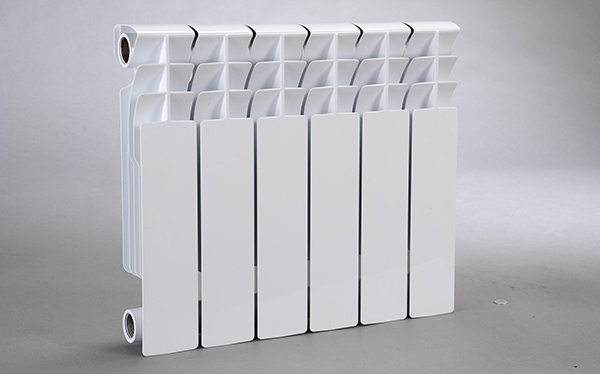
Photo 2. White aluminum radiator, consisting of six sections. Has high heat output, easy to install.
Anodized radiators — this type is made from highly purified aluminum that undergoes anodization (oxidation). The structure of the metal changes its properties during the chemical process, is not subject to corrosion and becomes durable, capable of withstanding 50–70 atmospheres. Their price is quite high.
Aluminum radiators are not distinguished by their exquisite design — these are ordinary flat panels of white color. It is this simplicity that allows them to fit well into any interior.
Advantages and disadvantages
The positive features of batteries are:
- ease of installation;
- possibility of washing with specialized products;
- possibility of connecting a thermostat;
- high heat transfer;
- heating speed;
- resistance to external corrosion (good coverage);
- The special design heats a large number of air flows.
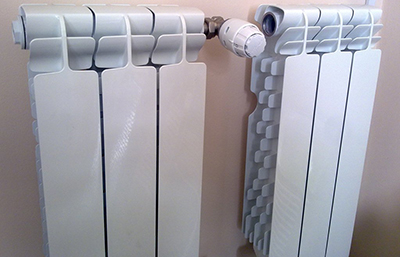
The disadvantages include:
- possibility of mechanical damage to the radiator (due to the softness of the metal);
- rapid loss of temperature;
- predisposition to air trapping;
- the need for water with a stable Ph;
- instability to water hammer.
Calculation of the power of sectional or collector radiators at h=500, the temperature of the energy carrier in 70 °C and working pressure 10-20 atmospheres makes up 175–199 W.
Under the same conditions, the heat output of anodized batteries is 216 W.
For good heating there should be a distance of 3 cm, between the floor and the battery - 10 cm, between the window sill and the radiator - about 2-3 cm.
Operation and price
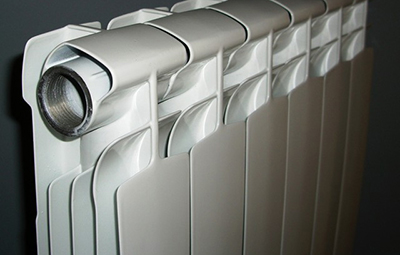
Guaranteed operational period of work from ten to twenty years (depending on the manufacturer).
But the service life can be extended if periodic maintenance is carried out. technical inspection and eliminate accumulated problems.
The estimated cost of batteries is from 1500 rubles into four sections, up to 4500 - on twelve ribs.
Steel wall
This type of wall radiators is made of thin sheet steel with a thickness of 1.25 or 0.3–0.5 mm, painted several times - to reduce the risk of corrosion. The market offers three types of radiators:
- Tubular - not very common, working pressure 12 atmospheres. They consist of several rows of tubes located: vertically, horizontally or at an angle.
- Sectional — consist of sections, are not in great demand, as they can withstand little pressure (up to 6 atmospheres).
- Panel — the most popular models, capable of withstanding up to 9 atmospheres. They are made by stamping. During stamping, vertical or U-shaped channels are squeezed out on the panels for the passage of the energy carrier. If the design requires it, convectors are installed on the device. Then all the seams are welded, the pipes are cut in, the seams are ground and the radiators are painted. The case can be removed and the battery can be washed inside.
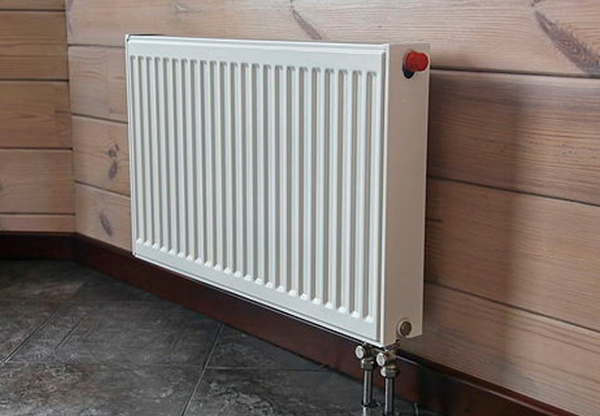
Photo 3. White steel panel radiator with high heat output and energy saving level, easy to clean.
The batteries differ from each other in the number of panels and convectors installed between them. These indicators are reflected in the marking: for example, type 10: “1” – one panel, “0” – no convectors; type 21: “2” – 2 panels, “1” – one convector.
Tubular radiators resemble Soviet cast iron ones in appearance, panel radiators are as flat as aluminum ones. They can be: white, colored (depending on the manufacturer or additional service of the supplier), designer with ornaments.
Pros and cons
The positive qualities of batteries include:
- simplicity of design;
- ease of installation;
- high heat transfer;
- the possibility of additionally installing a thermostat;
- high level of energy saving;
- ease of maintenance and cleaning (including inside).
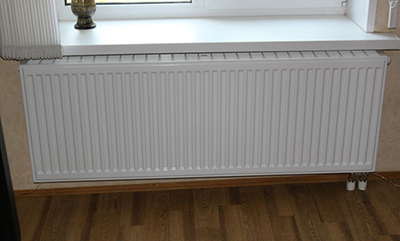
The obvious disadvantages are:
- negative reaction to the draining of the coolant;
- high risk of contamination;
- risk of corrosion (require increased attention to the coating);
- instability to water hammer;
- incompatibility with polypropylene pipes;
- Suitable for closed-type systems only.
The heat output of these batteries depends not only on how much pressure there is in the system, but also on number of panels and length, For example:
| type 22 | - | type 33 | - |
| length 400 mm | 576 kW | length 400 mm | 960 kW |
| length 2000 mm | 2878 kW | length 2000 mm | 4477 kW |
Service life and cost
The average service life of a steel radiator is 10 years, but with a gentle Ph, attention to the integrity of the coating and the installation of a dirt-retaining filter inside, the batteries are capable of serving about half as long.
The panel radiator is worth it from 3300 rubles per piece, tubular four-rib — from 9300.
Bimetallic
Bimetallic batteries are:
- Monolithic (solid cast) — are made by stamping from steel and aluminum alloys.
- Sectional (cabinet) — are a construction made of two metals:
- inner part, through which the heated coolant circulates, is made of stainless steel, less often - copper;
- external - casing, made of aluminum.
This determines: high resistance of devices to aggressive coolant, resistance to unstable hydraulic pressure in the system, ease of heat transfer.
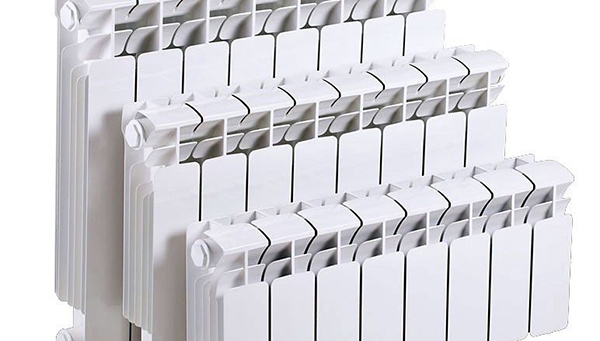
Photo 4. Three bimetallic sectional batteries of white color, resistant to pressure drops in the system.
Bimetallic radiators are able to withstand from 16 to 35 atmospheres.
Simple shapes fit the battery well for any interiorThey come in white and colored.
If the presented options do not suit you, then you can paint the unit yourself.
Advantages and disadvantages
The beneficial advantages of this type are:
- resistance to system pressure changes;
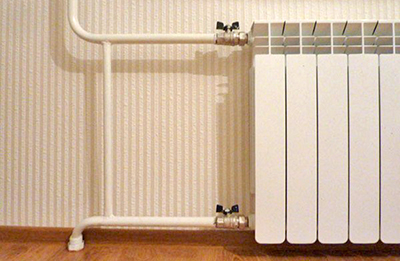
- indifference to the type of coolant;
- high heat transfer;
- resistance to water hammer;
- possibility of additional installation of a thermostat;
- In sectional ones you can assemble a battery of the required length.
This type has few disadvantages:
- The rubber gaskets between the radiator sections wear out over time, which may lead to battery repair;
- Different expansion of metals has a negative impact on performance: after some time, the radiator may start to creak or its thermal conductivity may decrease.
Attention! You can check the quality of the model with your fingers: you have to try it bend a corner - if the device is of poor quality, it will bend.
Bimetallic radiators with an aluminum casing can easily be confused with aluminum ones. They can be distinguished by weight: bimetallic much heavier because of the steel core.
Heat output of the battery, depending on the model, operating pressure and coolant temperature in 70 °C makes up from 130 to 200 W.
Warranty and price
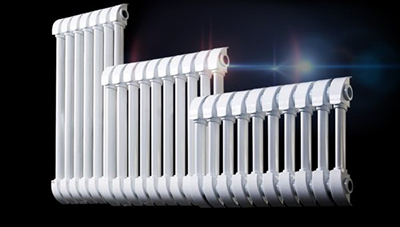
Manufacturers guarantee about 25 years old work for sectional batteries, although it can be extended with proper maintenance (flushing and replacing gaskets), and about 50 years old for monolithic.
The cost of the device starts from 2300 rubles for 4 sections, monolithic - from 3600.
How to choose for a closed system?
When choosing batteries, you need to take into account the following factors:
- instability of pressure inside the system;
- water hammer during preparation for the heating season;
- high content of additives in the coolant.
Attention! Taking these points into account, the following are suitable for a central closed system: cast iron and bimetallic radiators. Other types do not meet the requirements for one or more parameters.
Useful video
Video review of different types of radiators intended for central heating systems.
Radiator heat - for a long time
When choosing radiators for your home or apartment, you need to carefully study technical data sheet of the device and compare with your wishes and system data. Only compliance of parameters will allow you to get the desired heat, durability and trouble-free operation from the battery.








